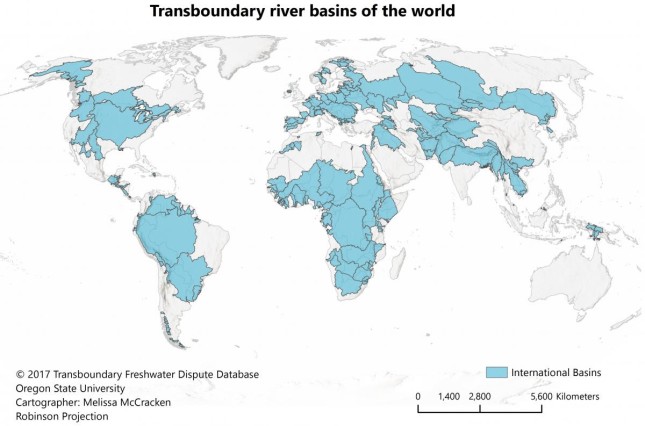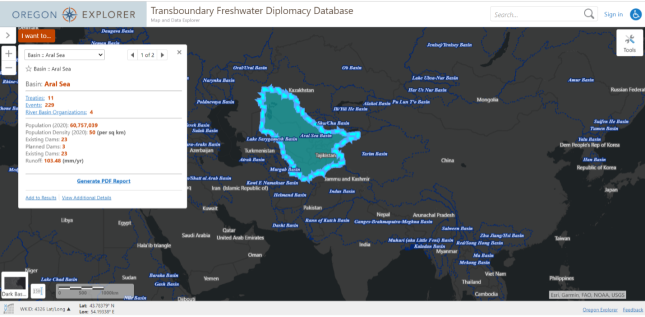-
Tracking Conflict and Cooperation Over the World’s International Freshwater Resources

Waters that cross international political borders can drive the countries that share them to conflict—or encourage cooperation between them. Indeed, since the 1940s, overall trends point to a tendency for countries to cooperate over shared water resources, which stands in stark contrast to media portrayals of “water wars.”
Yet instances of conflict over water have increased slightly since 2000. Why? Most of them are fueled by water quantity disputes or the unilateral development of dams or other infrastructure. Institutions often play a key role in facilitating cooperation (and reducing conflict) over shared waters, but their growth and adoption have slowed over the last two to three decades.
Tracking these trends is an essential undertaking. The Transboundary Freshwater Diplomacy Database (TFDD) was developed in 1997 (as the “Transboundary Freshwater Dispute Database”) to offer critical insights to researchers, practitioners, and policymakers. The platform is currently undergoing both a rebranding and a major update to extend its capacity and analytic power—as well as offer early warnings of incipient conflicts.
Transboundary Waters: Diving into the Data
Many of the world’s water resources are transboundary in nature, with 313 river and lake basins, more than 300 wetlands, and almost 600 aquifers stretching across international political borders. Surface water basins cover 47 percent of the earth’s land surface, and account for around 60 percent of freshwater flow. These waters are also home to 52 percent of the world’s population.
Climate change, population growth, and uneven patterns of economic development are contributing to the depletion and contamination of transboundary freshwater resources in many parts of the world. These trends demonstrate how water resources may become potential sources of conflict and cooperation.
This idea that widespread and violent conflicts inevitably develop over internationally shared water has been prevalent in media and policymaking circles for decades. However, researchers from around the world have demonstrated that water is more likely to be a source of cooperation. Based on the rich information collected in the Transboundary Freshwater Diplomacy Database and its latest updates, the following findings are of particular relevance and interest:
- Cooperation Prevails Over Conflict: Since 1948, 77 percent of the 6,400 water interactions on record have been cooperative, and only 19 percent of them involved conflict. However, there has been a slight increase in conflictive events since 2000. Moreover, some scholars have noted complicating factors in these findings. First, conflict and cooperation can be present simultaneously within a particular situation. Second, not all cooperation is “good.” Sometimes such cooperation cements power imbalances or embeds injustice within agreements.
- Amounts and Infrastructure: Most conflicts relate to disputes over water quantity or the development of shared water resources by one country (e.g., dams or other infrastructure). Dam development in the Global South is increasing, particularly with efforts to increase the production of renewable energy and adapt to climate change through increased storage capacity, creating increased potential for tension.
- Institutional Capacity is Essential but Stagnating: Treaties and river basin organizations (RBOs) play a key role in reducing conflict—both in frequency and intensity. Strengthening cooperation through these institutions is important. Yet despite the importance of institutions for water cooperation, the number of treaties signed each year has been declining since the 1990s. Only 13 RBOs have been established since 2002. Further evidence of this trend can be found in the fact that only 14 percent of 830 treaties and other legal documents pertaining to international water management address entire river basins; many remain bilateral, even in multilateral basins. This poses challenges to the principle of integrated basin management, which has also been put forward under UN Sustainable Development Goal (SDG) 5.
The troubling trends of increasing conflict (since 2000) and slowing institutionalization of cooperation through basin treaties and RBOs pose significant challenges. An endless growth of institutions is, of course, not expected—there will be a saturation once most basins have these instruments—yet there are basins that remain without either treaties or RBOs. This absence challenges the potential role of institutions in conflict prevention and mitigation.
These trends also merit the international community’s attention, as they could put sustainable water resource management, as well as peace and stability, at risk. Research at Oregon State University that both the likelihood and intensity of conflict related to water resources rise as the rate of change within a river basin exceeds the institutional capacity to absorb that change.
Tracking Trends for Early Warnings
This is why the monitoring already accomplished by the Transboundary Freshwater Diplomacy Database has been so important. Monitoring empirically derived parameters to help identify international river basins that are at elevated conflict risk is crucial for mobilizing development partners to assist in preventing or mitigating problems before they reach crisis levels.
For example, monitoring for planned upstream dams (a rapid “change”) in the absence of agreements for dealing with their downstream impacts (“institutional capacity”) can offer an early warning of the importance of focused dialogue and diplomacy in advance of a crisis.
The newly rebranded Transboundary Freshwater Diplomacy Database (TFDD) will now extend and expand this effort, creating a state-of-the-art Geographic Information System of the world’s international river basins and their institutions.
In collaboration with colleagues at The Fletcher School at Tufts University, IHE-Delft, GWP, IUCN, and IW-Learn, and in coordination with and the support of the Global Environment Facility and the World Bank, updates to the TFDD will result in a current and accessible database, capturing key indicators of conflict potential and active cooperation.
These changes will also provide early warnings for potential tensions over transboundary river basins through an interactive and comprehensive map of all international water basins and aquifers.
Underlying data, such as the updated collections of freshwater treaties, RBOs, and events, will also be accessible through this interface. The following updated datasets are available, with more new updates underway to bring the collections up to date. Combined with other existing information, they will help identify potential hydropolitical hot spots, as well as assist in all manner of governance and legal best practices research:
- International Freshwater Treaties Database: A searchable database of the full text of more than 800 international freshwater agreements covering the years 1820 to 2020. Documents are coded for over 100 indicators, such as basins and countries involved, allocation mechanisms, dispute resolution mechanisms, water quality provisions, and stakeholder participation.
- International Water Event Database: A searchable database documenting over 6,400 historical international water interactions from 1948 to 2008. Each event is rated for its conflict/cooperation intensity.
- International River Basin Organization (RBO) Database: A searchable database that provides detailed institutional design data on more than 120 RBOs in more than 110 transboundary watercourses. It was created by Susanne Schmeier, and the current update will add newly created RBOs and track institutional changes to existing ones.
- Transboundary Wetland Database: A database of more than 300 transboundary wetlands created by Zoe Rosenblum that includes information on Ramsar designation, situatedness within international river basins, and the presence of an RBO. A new update will expand this dataset to include wetlands not recognized by the Ramsar Convention.
- Transboundary Freshwater Spatial Database: Contains biophysical, socioeconomic, and geopolitical data on the world’s 313 international river basins. In collaboration with the OSU Valley Library, a new tool that links all the database components under one interactive map is being developed.
As the TFDD approaches its 25th year with a new name and expanded databases, its continuing goal to provide open access to global information and experience on the world’s shared water resources remains. This work is undertaken in the hope that such knowledge can contribute to better management, richer dialogue, and, ideally, even environmental peacebuilding over one of our most precious and vulnerable resources.
Alexandra Caplan is a PhD student in the geography program at Oregon State University and is manager of the Transboundary Freshwater Diplomacy Database.
Melissa McCracken is an assistant professor of international environmental policy at the Fletcher School at Tufts University, where she also directs the Shared Waters Lab.
Susanne Schmeier, LLM, is an Associate Professor of Water Law and Diplomacy at IHE Delft and works on the legal and institutional dimensions of water conflict and cooperation in basins around the world.
Zoe Rosenblum is a PhD student in the geography program at Oregon State University, where her research focuses on transboundary wetland governance.
Aaron Wolf is a professor of geography at Oregon State University, USA, with an appointment as professor of water diplomacy at IHE-Delft Institute for Water Education in the Netherlands, who directs the Program in Water Conflict Management and Transformation, through which he has offered workshops, facilitations, and mediation in basins throughout the world.
Sources: International Environmental Agreements: Politics, Law and Economics; International Journal of Water Resources Development; Journal of Peace Research; MDPI; Oregon State University; Water Policy
Photo credit: Map detailing the transboundary river basins of the world, courtesy of Melissa McCracken and Oregon State University.
 A Publication of the Stimson Center.
A Publication of the Stimson Center.

 Screenshot of the new interactive map being developed in collaboration with the OSU Valley Library
Screenshot of the new interactive map being developed in collaboration with the OSU Valley Library

